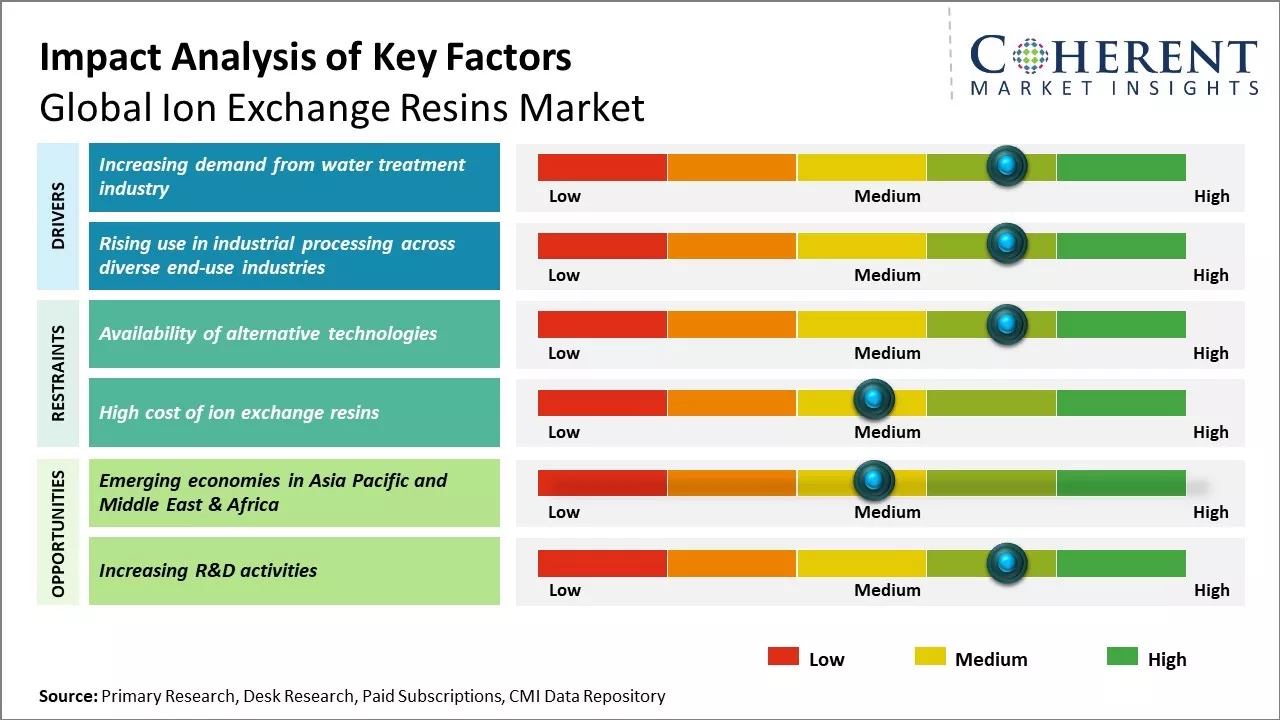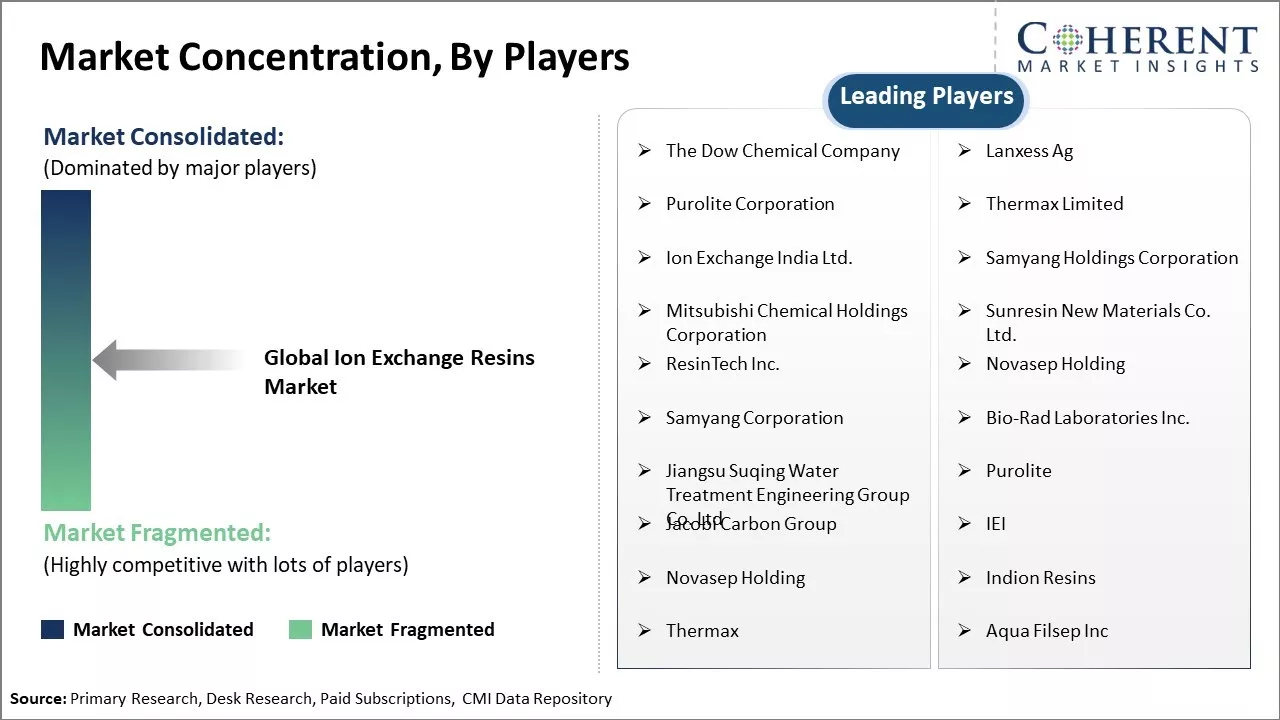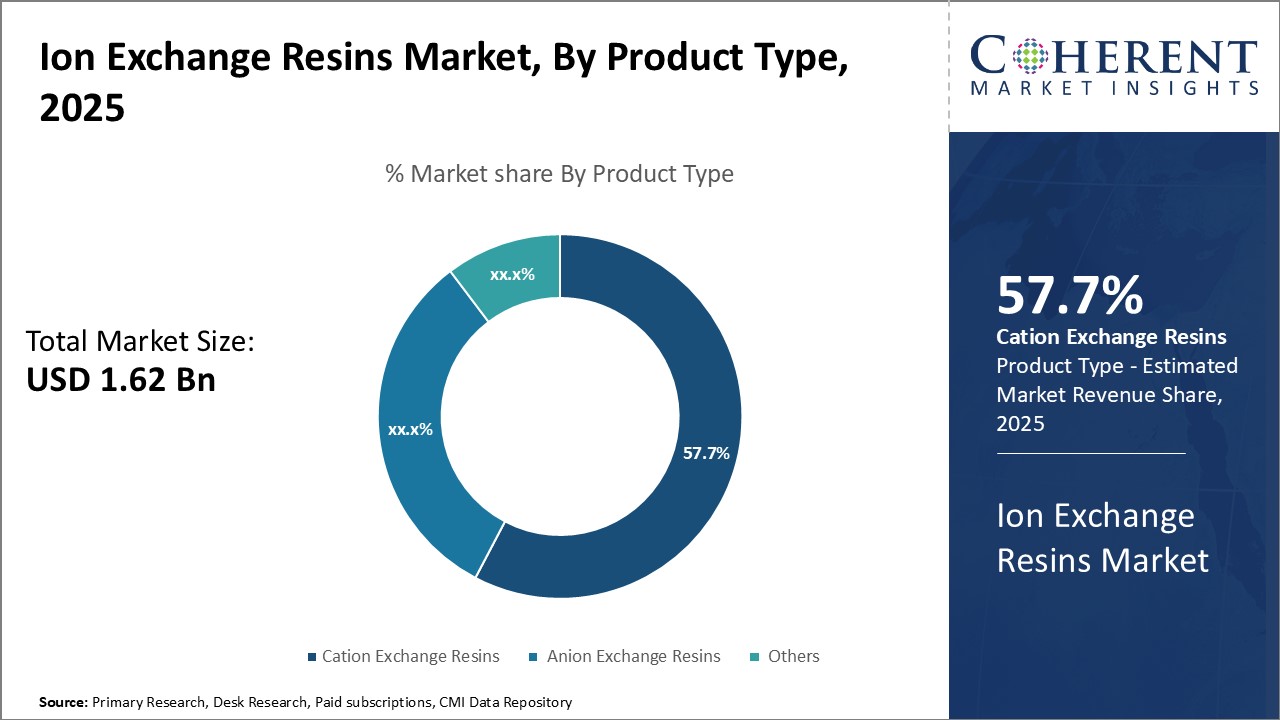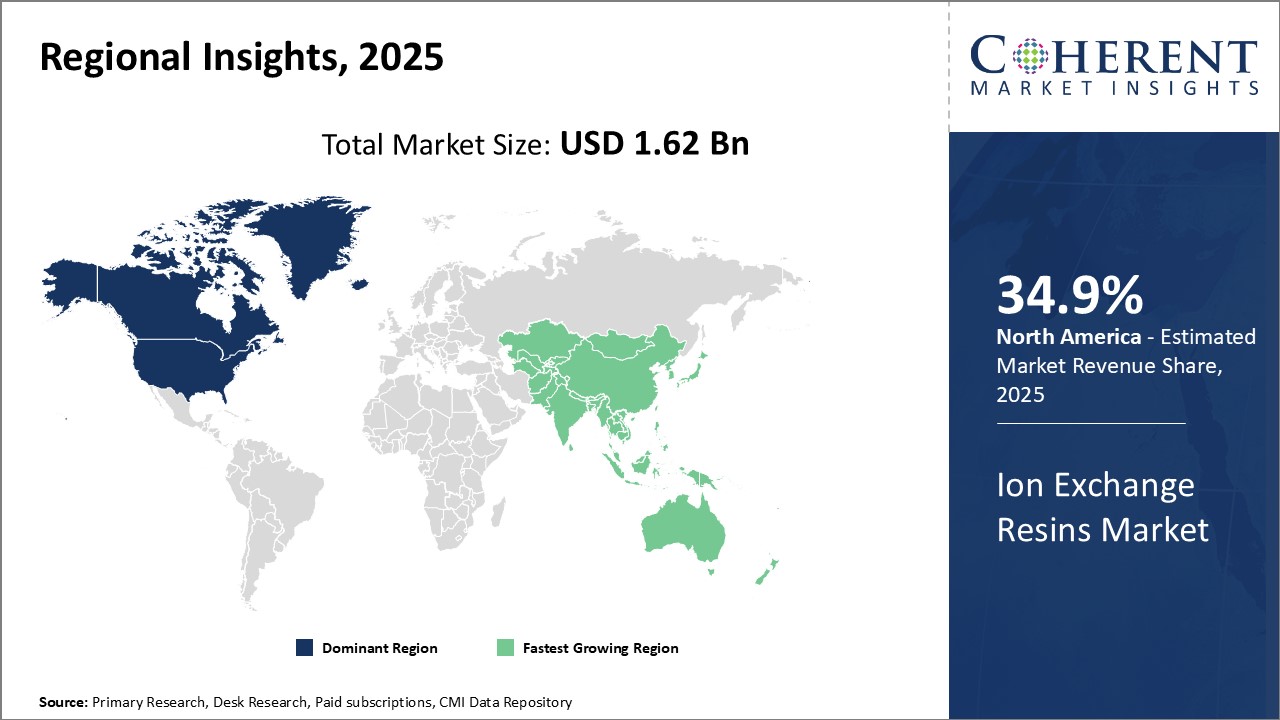The ion exchange resins market is estimated to be valued at USD 1.62 Bn in 2025 and is expected to reach USD 2.28 Bn by 2032, exhibiting a compound annual growth rate (CAGR) of 5.0% from 2025 to 2032.

Discover market dynamics shaping the industry: Download Free Sample
The ion exchange resins market is expected to witness substantial growth over the forecast period. The increasing demand from various end-use industries such as power, chemical & petrochemical, food & beverage, pharmaceutical, mining & metallurgy, and others is expected to drive the market growth during the forecast period. Ion exchange resins are mainly used in the regeneration process of water purification systems which is gaining importance due to increasing water pollution. Additionally, ion exchange resins have wide applications in the production of numerous drugs and medicines which is further supporting the market growth. However, the availability of cost-effective substitutes and stringent regulations regarding the use of ion exchange resins may hamper the market growth during the forecast period.
Increasing demand from water treatment industry
The water treatment industry has been experiencing substantial growth over the past few years driven by increasing concerns over water scarcity and rising pollution levels globally. With growing population and rapid urbanization, the demand for clean and potable water is continuously rising. This has propelled investments in water processing, reuse, and desalination plants across countries. Ion exchange resins play a crucial role in various stages of industrial and municipal water treatment processes by removing dissolved impurities and ions. They are extensively used for the purification of raw water sources, production of ultrapure water for industrial applications, water softening, process stream polishing, and effluent treatment.
In particular, demand from seawater desalination has significantly contributed to the growing consumption of ion exchange resins. With drought becoming a recurring problem, many coastal cities and towns are looking at desalination as a reliable and sustainable source of freshwater. Several large desalination plants based on reverse osmosis technology have come online in the Middle East, North Africa, and California in recent times. Reverse osmosis membranes require pre-treatment of feed water to remove salinity, hardness, organic compounds and particles, for which ion exchange resins play a critical pre-treatment role. Their use helps prolong the lifespan of desalination membranes and enhances overall plant efficiency.

Get actionable strategies to beat competition: Download Free Sample
Rising use in industrial processing across diverse end-use industries
Ion exchange resins are extensively used across diverse process industries such as power generation, pharmaceuticals, food and beverages, semiconductors, chemicals and petrochemicals for various applications like polishing of process water, removal of impurities from boilers, and purification in production streams. With robust economic growth and rapid industrialization witnessed globally over the past decade, the demand from the industrial processing sector has significantly increased.
For instance, in the power sector, ion exchange resins are utilized to remove dissolved solids, suspended solids and ions from boiler feed water and cooling tower blowdown. This enhances the efficiency of steam generation and prevents scale deposits as well as corrosion inside boilers. Similarly, in semiconductor manufacturing, ultrapure water production using ion exchange resins is indispensable. Their use ensures the elimination of ionic and organic contaminants to parts per trillion levels.
Key Takeaways from Analyst:
The growth of water treatment industries across regions will be a key driver for the resin demand. Industries, such as power, chemical, pharmaceuticals, and food & beverage, are major consumers of treated water, thereby promoting the use of ion exchange resins. Moreover, increasing stringent regulations regarding waste water disposal are encouraging the uptake of ion exchange resins for industrial effluent treatment.
Availability of alternative technologies for water purification can act as a restraint. Membrane technologies like reverse osmosis are gaining traction in some applications. Also, fluctuating raw material prices remain a concern. But continued investments in urban water infrastructure in developing nations will help offset such restraints.
The Asia Pacific region dominates the global market currently and trends suggest it will continue fastest growth over the forecast period. This can be attributed to the rapidly expanding manufacturing industries and growing focus on clean water accessibility in populous countries like India and China. North America and Europe will continue to provide a steady demand for ion exchange resins as well due to stringent environmental regulations and presence of leading resin producers in these regions.
Market Challenges: Availability of alternative technologies
The availability of alternative technologies is significantly restraining the growth of the global ion exchange resins market. Technologies like membrane separation processes and activated carbon are posing a serious threat to the ion exchange resin market. Membrane separation processes utilize nano-filtration and reverse osmosis techniques for separation of ions and purification of water. These processes provide higher purification efficiency and require lower capital and operating costs compared to ion exchange resins over the long-term. Many end-use industries are preferring membrane separation over ion exchange resins for their treatment needs. The power, chemical, food & beverage industries have widely adopted membrane technologies for diverse purification applications in the last 5-7 years.
Market Opportunities: Emerging economies in Asia Pacific and Middle East & Africa
The emerging economies in Asia Pacific and Middle East & Africa regions present a huge growth opportunity for the global ion exchange resins market. These regions are witnessing rapid industrialization and infrastructure development which is increasing the demand for treated water.
Overall, the booming economic conditions, increasing industrial water footprint and expanding access to clean water in Asia Pacific and Africa are poised to catapult the ion exchange resins market to new heights in the coming years. The continued heavy investments in key industries and infrastructure hold out the promise of sustained demand well into the future.

Discover high revenue pocket segments and roadmap to it: Download Free Sample
Insights by Product Type: Cation Exchange Resins Dominate Due to Wide Scope of Applications
Cation exchange resins are expected to contribute 57.7% share of the ion exchange resins market in 2025, owing to their broad usage across industries. These resins have cationic functional groups that can selectively exchange positively charged ions from solutions. Their ability to remove positively charged ions like calcium, magnesium, sodium, and potassium makes them highly applicable for water softening. Cation resins are extensively used for softening household and industrial water to reduce scale formation in boilers and reduce soap consumption. They are also used for purification in food processing to remove unwanted metal ions.
Cation exchange resins find widespread application in water treatment plants for municipal as well as industrial wastewater. They effectively reduce water hardness and help meet stringent discharge limits. Many power plants also utilize cation exchange to treat boiler feedwater and cooling tower blowdown. This helps control scale, maintain cycle chemistry, and reduce corrosion in carbon steel and copper alloy heat exchangers. Cation resins are further advantageous for processes like sugar decolorization, recovery of metals from leach solutions, and production of high-purity chemicals and pharmaceuticals.
Their competence to selectively eliminate specific metal cations without disturbing other ions provides cation resins gives an edge over other separation techniques. This makes them irreplaceable for applications requiring ultra-pure water. Steady growth of core end-use industries like food & beverage, power, chemicals, and pharmaceuticals is anticipated to drive the demand for cation exchange resins in the coming years. Constant innovation to deliver improved resin stability, regenerability, and service life will further aid in market penetration.
Insights by Application: Power Generation Drives Demand due to the Need for Demineralized Water
The power generation segment is expected to account 40.4% share of the overall ion exchange resins market in 2025. Thermal and nuclear power plants have stringent water quality norms to minimize corrosion, scale, and deposition issues. They require demineralized water with very low ionic content as makeup for boiler, cooling, and other process needs. Ion exchange finds widespread use in demineralizing condensate, feedwater, and various wastewaters in power plants. Both cation and anion exchange resins are used in mixed-bed and separate-bed demineralizers to bring total dissolved solids below desirable limits.
Reliable power output and equipment life necessitate careful boiler water chemistry control. Ion exchange resins play a pivotal role in adjusting and stabilizing water parameters like pH, conductivity, and cation/anion ratios. Their application helps remove scale-causing ions and minimizes oxygen corrosion. Resins also separate various radionuclides in nuclear plant secondary coolant circuits and facilitate radioactive waste treatment. With mounting power demand globally, utilities are undertaking capacity expansion and upgrading aging assets. This will substantially augment the installed base of ion exchange-based water purification systems.
Strict environmental norms regarding brine and sludge disposal further drive the resin preference over competitive technologies. Growing focus on reducing carbon footprint through efficient operations also raises the importance of optimizing cycle chemistry. Overall, the reliability, flexibility, and waste minimizing ability of ion exchange resins continues to support their widespread adoption in steam generation.

Need a Different Region or Segment? Download Free Sample
North America has been dominating the global ion exchange resins market, and it is expected to continue its dominance over the forecast period accounting for 34.9% of the market share in 2025. The region accounts for the largest market share currently due to a strong presence of major players in countries like the U.S. and Canada. The companies based in North America are the global leaders in ion exchange resin manufacturing and technology with widespread production facilities. Moreover, industrial sectors like chemical processing that extensively use ion exchange resins are highly developed in the region. Also, prominent research and development activities carried out by market participants and research institutes help North America maintain an edge over other regions. Stringent environmental regulations regarding wastewater treatment have also propelled the demand for ion exchange resins from various end-use industries in the region.
Asia Pacific region has emerged as the fastest growing market for ion exchange resins globally. Rapid industrialization and economic growth of countries like China and India have been the major driver of the Asia Pacific ion exchange resins market. Growing population, rising disposable income, and improving living standards have resulted in the increased demand for consumer goods as well as energy and power in Asia Pacific. This has spurred the requirement for ion exchange resins from various process industries and municipal water treatment plants across the region. Additionally, the shift of production facilities of global players to the region owing to the availability of cheap labor and land have augmented the market growth. Rising export activities of chemical products from the region have also boosted the export of ion exchange resins. However, price competitiveness due to the presence of local manufacturers is a factor challenging the established foreign players in the Asia Pacific ion exchange resins market.
Ion Exchange Resins Market Report Coverage
| Report Coverage | Details | ||
|---|---|---|---|
| Base Year: | 2024 | Market Size in 2025: | USD 1.62 Bn |
| Historical Data for: | 2020 To 2024 | Forecast Period: | 2025 To 2032 |
| Forecast Period 2025 to 2032 CAGR: | 5.0% | 2032 Value Projection: | USD 2.28 Bn |
| Geographies covered: |
|
||
| Segments covered: |
|
||
| Companies covered: |
The Dow Chemical Company, Lanxess Ag, Purolite Corporation, Thermax Limited, Ion Exchange India Ltd., Samyang Holdings Corporation, Mitsubishi Chemical Holdings Corporation, Sunresin New Materials Co. Ltd., ResinTech Inc., Novasep Holding, Samyang Corporation, Bio-Rad Laboratories Inc., Jiangsu Suqing Water Treatment Engineering Group Co. Ltd, Purolite, Jacobi Carbon Group, IEI, Novasep Holding, Indion Resins, Thermax, and Aqua Filsep Inc |
||
| Growth Drivers: |
|
||
| Restraints & Challenges: |
|
||
Uncover macros and micros vetted on 75+ parameters: Get instant access to report
*Definition: Ion exchange resins are synthetic polymeric materials that are capable of exchanging specific ions within a solution with ions from the resin. They are commonly used in the water treatment, purification, and separation processes.
Share
Share
About Author
Vidyesh Swar is a seasoned Consultant with a diverse background in market research and business consulting. With over 6 years of experience, Vidyesh has established a strong reputation for his proficiency in market estimations, supplier landscape analysis, and market share assessments for tailored research solution. Using his deep industry knowledge and analytical skills, he provides valuable insights and strategic recommendations, enabling clients to make informed decisions and navigate complex business landscapes.
Missing comfort of reading report in your local language? Find your preferred language :
Transform your Strategy with Exclusive Trending Reports :
Frequently Asked Questions
Joining thousands of companies around the world committed to making the Excellent Business Solutions.
View All Our Clients